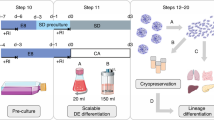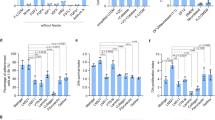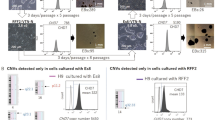Abstract
The large-scale and cost-effective production of quality-controlled human pluripotent stem cells (hPSCs) for use in cell therapy and drug discovery would ideally require a chemically defined xenobiotic-free culture system. Towards the development of such a system, costs associated with the use of recombinant proteins as supplements in basal culture media need to be reduced. Here, we describe a growth-factor-free culture medium that uses just three chemical compounds and a lower number of recombinant proteins than used in commercially available media. We show that the culture medium supports the long-term propagation of hPSCs, as confirmed by karyotype, the expression of pluripotency markers and the capacity to differentiate into cell types derived from the three embryonic germ layers. hPSCs growing in the medium were less dependent on glycolytic pathways than cells grown in medium containing growth factors. Moreover, the medium supported the generation of induced pluripotent stem cells derived from either human dermal fibroblasts or peripheral blood mononuclear cells. Our findings should facilitate the ongoing development of a completely xeno-free, chemically defined, synthetic culture system for hPSCs.
This is a preview of subscription content, access via your institution
Access options
Access Nature and 54 other Nature Portfolio journals
Get Nature+, our best-value online-access subscription
$29.99 / 30 days
cancel any time
Subscribe to this journal
Receive 12 digital issues and online access to articles
$99.00 per year
only $8.25 per issue
Buy this article
- Purchase on Springer Link
- Instant access to full article PDF
Prices may be subject to local taxes which are calculated during checkout




Similar content being viewed by others
References
Thomson, J. A. et al. Embryonic stem cell lines derived from human blastocysts. Science 282, 1145–1147 (1998).
Takahashi, K. et al. Induction of pluripotent stem cells from adult human fibroblasts by defined factors. Cell 131, 861–872 (2007).
Melton, D. A. Applied developmental biology: making human pancreatic beta cells for diabetics. Curr. Top. Dev. Biol. 117, 65–73 (2016).
Chen, G. et al. Chemically defined conditions for human iPSC derivation and culture. Nat. Methods 8, 424–429 (2011).
Pera, M. F. & Tam, P. P. Extrinsic regulation of pluripotent stem cells. Nature 465, 713–720 (2010).
Hasegawa, K. et al. Wnt signaling orchestration with a small molecule DYRK inhibitor provides long-term xeno-free human pluripotent cell expansion. Stem Cells Transl. Med. 1, 18–28 (2012).
Beers, J. et al. Passaging and colony expansion of human pluripotent stem cells by enzyme-free dissociation in chemically defined culture conditions. Nat. Protoc. 7, 2029–2040 (2012).
Nie, Y., Walsh, P., Clarke, D. L., Rowley, J. A. & Fellner, T. Scalable passaging of adherent human pluripotent stem cells. PLoS ONE 9, e88012 (2014).
Miyazaki, T. et al. Laminin E8 fragments support efficient adhesion and expansion of dissociated human pluripotent stem cells. Nat. Commun. 3, 1236 (2012).
Jin, S., Yao, H., Weber, J. L., Melkoumian, Z. K. & Ye, K. A synthetic, xeno-free peptide surface for expansion and directed differentiation of human induced pluripotent stem cells. PLoS ONE 7, e50880 (2012).
Suemori, H. et al. Efficient establishment of human embryonic stem cell lines and long-term maintenance with stable karyotype by enzymatic bulk passage. Biochem. Biophys. Res. Commun. 345, 926–932 (2006).
Sato, N., Meijer, L., Skaltsounis, L., Greengard, P. & Brivanlou, A. H. Maintenance of pluripotency in human and mouse embryonic stem cells through activation of Wnt signaling by a pharmacological GSK-3-specific inhibitor. Nat. Med. 10, 55–63 (2004).
Bellmaine, S. F. et al. Inhibition of DYRK1A disrupts neural lineage specification in human pluripotent stem cells. eLife 6, e24502 (2017).
Gwack, Y. et al. A genome-wide Drosophila RNAi screen identifies DYRK-family kinases as regulators of NFAT. Nature 441, 646–650 (2006).
Aranda, S., Laguna, A. & de la Luna, S. DYRK family of protein kinases: evolutionary relationships, biochemical properties, and functional roles. FASEB J. 25, 449–462 (2011).
Ohnuma, K. et al. Enzyme-free passage of human pluripotent stem cells by controlling divalent cations. Sci. Rep. 4, 4646 (2014).
Watanabe, K. et al. A ROCK inhibitor permits survival of dissociated human embryonic stem cells. Nat. Biotechnol. 25, 681–686 (2007).
Reubinoff, B. E., Pera, M. F., Fong, C. Y., Trounson, A. & Bongso, A. Embryonic stem cell lines from human blastocysts: somatic differentiation in vitro. Nat. Biotechnol. 18, 399–404 (2000).
Nakagawa, M. et al. Generation of induced pluripotent stem cells without Myc from mouse and human fibroblasts. Nat. Biotechnol. 26, 101–106 (2008).
Yu, J. et al. Induced pluripotent stem cell lines derived from human somatic cells. Science 318, 1917–1920 (2007).
Avery, S. et al. BCL-XL mediates the strong selective advantage of a 20q11.21 amplification commonly found in human embryonic stem cell cultures. Stem Cell Rep. 1, 379–386 (2013).
Merkle, F. T. et al. Human pluripotent stem cells recurrently acquire and expand dominant negative P53 mutations. Nature 545, 229–233 (2017).
Chambers, S. M. et al. Highly efficient neural conversion of human ES and iPS cells by dual inhibition of SMAD signaling. Nat. Biotechnol. 27, 275–280 (2009).
Minami, I. et al. A small molecule that promotes cardiac differentiation of human pluripotent stem cells under defined, cytokine- and xeno-free conditions. Cell Rep. 2, 1448–1460 (2012).
Si-Tayeb, K. et al. Highly efficient generation of human hepatocyte-like cells from induced pluripotent stem cells. Hepatology 51, 297–305 (2010).
Muthusamy, T., Mukherjee, O., Menon, R., Megha, P. B. & Panicker, M. M. A method to identify and isolate pluripotent human stem cells and mouse epiblast stem cells using lipid body-associated retinyl ester fluorescence. Stem Cell Rep. 3, 169–184 (2014).
Takashima, Y. et al. Resetting transcription factor control circuitry toward ground-state pluripotency in human. Cell 158, 1254–1269 (2014).
Sperber, H. et al. The metabolome regulates the epigenetic landscape during naive-to-primed human embryonic stem cell transition. Nat. Cell Biol. 17, 1523–1535 (2015).
Okita, K. et al. A more efficient method to generate integration-free human iPS cells. Nat. Methods 8, 409–412 (2011).
Ludwig, T. E. et al. Derivation of human embryonic stem cells in defined conditions. Nat. Biotechnol. 24, 185–187 (2006).
Okita, K. et al. An efficient nonviral method to generate integration-free human-induced pluripotent stem cells from cord blood and peripheral blood cells. Stem Cells 31, 458–466 (2013).
Lin, T. et al. A chemical platform for improved induction of human iPSCs. Nat. Methods 6, 805–808 (2009).
Nakagawa, M. et al. A novel efficient feeder-free culture system for the derivation of human induced pluripotent stem cells. Sci. Rep. 4, 3594 (2014).
Chou, B. K. et al. A facile method to establish human induced pluripotent stem cells from adult blood cells under feeder-free and xeno-free culture conditions: a clinically compliant approach. Stem Cells Transl. Med. 4, 320–332 (2015).
Zhou, H. et al. Rapid and efficient generation of transgene-free iPSC from a small volume of cryopreserved blood. Stem Cell Rev. 11, 652–665 (2015).
Higuchi, Y. et al. Specific direct small molecule p300/beta-catenin antagonists maintain stem cell potency. Curr. Mol. Pharmacol. 9, 272–279 (2016).
Foucourt, A. et al. Design and synthesis of thiazolo[5,4-f]quinazolines as DYRK1A inhibitors, part I. Molecules 19, 15546–15571 (2014).
Foucourt, A. et al. Design and synthesis of thiazolo[5,4-f]quinazolines as DYRK1A inhibitors, part II. Molecules 19, 15411–15439 (2014).
Janda, C. Y. et al. Surrogate Wnt agonists that phenocopy canonical Wnt and beta-catenin signalling. Nature 545, 234–237 (2017).
Nguyen, E. H. et al. Versatile synthetic alternatives to Matrigel for vascular toxicity screening and stem cell expansion. Nat. Biomed. Eng. 1, 0096 (2017).
Chen, Y. M. et al. Xeno-free culture of human pluripotent stem cells on oligopeptide-grafted hydrogels with various molecular designs. Sci. Rep. 7, 45146 (2017).
Otsuji, T. G. et al. A 3D sphere culture system containing functional polymers for large-scale human pluripotent stem cell production. Stem Cell Rep. 2, 734–745 (2014).
Lyssiotis, C. A. et al. Reprogramming of murine fibroblasts to induced pluripotent stem cells with chemical complementation of Klf4. Proc. Natl Acad. Sci. USA 106, 8912–8917 (2009).
Hasegawa, K., Fujioka, T., Nakamura, Y., Nakatsuji, N. & Suemori, H. A method for the selection of human embryonic stem cell sublines with high replating efficiency after single-cell dissociation. Stem Cells 24, 2649–2660 (2006).
Wells, C. A. et al. Stemformatics: visualisation and sharing of stem cell gene expression. Stem Cell Res. 10, 387–395 (2013).
Ohgushi, M., Minaguchi, M. & Sasai, Y. Rho-signaling-directed YAP/TAZ activity underlies the long-term survival and expansion of human embryonic stem cells. Cell Stem Cell 17, 448–461 (2015).
Gaidatzis, D., Lerch, A., Hahne, F. & Stadler, M. B. QuasR: quantification and annotation of short reads in R. Bioinformatics 31, 1130–1132 (2015).
Sun, J., Nishiyama, T., Shimizu, K. & Kadota, K. TCC: an R package for comparing tag count data with robust normalization strategies. BMC Bioinformatics 14, 219 (2013).
Tang, M., Sun, J., Shimizu, K. & Kadota, K. Evaluation of methods for differential expression analysis on multi-group RNA-seq count data. BMC Bioinformatics 16, 360 (2015).
Luo, W. & Brouwer, C. Pathview: an R/Bioconductor package for pathway-based data integration and visualization. Bioinformatics 29, 1830–1831 (2013).
Robinson, J. T. et al. Integrative genomics viewer. Nat. Biotechnol. 29, 24–26 (2011).
Thorvaldsdottir, H., Robinson, J. T. & Mesirov, J. P. Integrative Genomics Viewer (IGV): high-performance genomics data visualization and exploration. Brief. Bioinformatics 14, 178–192 (2013).
Acknowledgements
We thank N. Nakatsuji (Kyoto University), M. F. Pera (The University of Melbourne), M. Kahn (University of Southern California) and J. Wu (The Salk Institute) for their critical discussion and helpful advice. We also thank C. Wells (The University of Melbourne), O. Korn and R. Mosbergen (Stemformtics) for their valuable input on transcriptome analysis, M. Kanno (CiRA, Kyoto University) for technical advice on iPSC derivation and A.-L. Skaltsounis (University of Athens) for providing materials. We also thank all lab members, especially N. Asari and J. Ueda, for experimental support and helpful discussions. This project was supported in part by a Start-Up Grant for Young Scientists (Kyoto University), an iCeMS Accelerated Project Grant (iCeMS, Kyoto University), and JSPS Grants-in-Aid for Young Scientist A and Scientific Research B (Japan Society for Promotion Science; grant numbers 24680052 and 15H03022) to K.H.; New Energy and Industrial Technology Development Organization (NEDO) Japan (P10027 and P14006) and Japan Agency for Medical Research and Development (AMED) to H.Su. and K.H.; and an iCeMS Overseas Visit Program for Young Researchers to S.-Y.Y.
Author information
Authors and Affiliations
Contributions
K.H. designed the project. S.-Y.Y., T.I., H.Sh., N.Y., M.H., B.N., H.Su. and K.H. performed the experiments. S.-Y.Y., T.I., H.Sh., N.V.-S., B.N. and K.H. analysed the data. S.-Y.Y., T.I., H.Sh., N.V.-S., B.N. and K.H. wrote the manuscript.
Corresponding author
Ethics declarations
Competing interests
K.H., S.-Y.Y., H.Sh. and N.Y. have applied for a patent on the culture system.
Additional information
Publisher’s note: Springer Nature remains neutral with regard to jurisdictional claims in published maps and institutional affiliations.
Supplementary information
Supplementary Information
Supplementary figures, tables, and movie and data captions.
Supplementary Dataset
Copy number variation and loss of heterozygosity of KhES‐1 and H9 cells after prolonged culture in AKIT, E8 and KSR/bFGF on feeder layer.
Supplementary Video 1
Beating cardiomyocytes differentiated from KhES‐1 cells at passage 33 in the AKIT system.
Rights and permissions
About this article
Cite this article
Yasuda, Sy., Ikeda, T., Shahsavarani, H. et al. Chemically defined and growth-factor-free culture system for the expansion and derivation of human pluripotent stem cells. Nat Biomed Eng 2, 173–182 (2018). https://doi.org/10.1038/s41551-018-0200-7
Received:
Accepted:
Published:
Issue Date:
DOI: https://doi.org/10.1038/s41551-018-0200-7
This article is cited by
-
Engineering considerations of iPSC-based personalized medicine
Biomaterials Research (2023)
-
Development and evaluation of a novel xeno-free culture medium for human-induced pluripotent stem cells
Stem Cell Research & Therapy (2022)
-
Reprogramming of fibroblasts into expandable cardiovascular progenitor cells via small molecules in xeno-free conditions
Nature Biomedical Engineering (2022)
-
A chemically-defined plastic scaffold for the xeno-free production of human pluripotent stem cells
Scientific Reports (2022)
-
Dual-specificity Tyrosine Phosphorylation-regulated Kinase Inhibitor ID-8 Promotes Human Somatic Cell Reprogramming by Activating PDK4 Expression
Stem Cell Reviews and Reports (2022)



